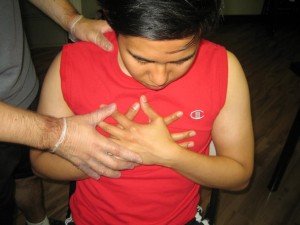Chest trauma is defined as a body wound or shock to the chest brought

about by sudden physical injury. Chest trauma can either be classified as blunt or trauma. Blunt chest trauma occurs when injury causes tissue damage but there is no tearing or penetration into the skin and muscle. On the other hand, penetrating chest trauma occurs when injury penetrates or pokes through the skin. There is an obvious break in the skin. The chest cavity is also called the thoracic cavity. It protects several of the body’s most essential organs, such as the heart and both lungs.
Causes of Chest Trauma
There are many potential causes of chest trauma, specifically, the most common causes include:
Blunt Chest Trauma
- Vehicular accidents
- Falls, especially at heights three times greater than the height of the person
- Physical assaults
Penetrating Chest Trauma
- Gunshot wounds
- Stab wounds
- Bite wounds
- Blast injuries or other penetrating foreign bodies
Signs and Symptoms of Chest Trauma
A blunt chest trauma may not always be seen by the naked eye since tissue damage is not always evident. On the contrary, a penetrating chest trauma is most likely noticeable even by the naked eye because of the evident break in the skin. Signs and symptoms of the two types of chest trauma will vary based on the cause, however, the most common signs and symptoms of chest trauma are the following:
Blunt Chest Trauma
- Chest pain
- Bruised or black and blue chest
- Difficulty breathing or respiratory distress
Penetrating Chest Trauma
- Bleeding wound (usually there is an obvious entry wound, and in some cases with exit wound)
- Chest pain
- Shortness of breath
- Sucking or gurgling sound, especially as air moves in and out of the pleural space through the wound
- Weakening pulse
First Aid Management for Chest Trauma
The most important danger to avoid in any kind of chest trauma is the cessation of breathing. For all cases of chest trauma, do not leave the patient alone at all times and follow the procedure to be given to ensure proper care is given.
- Before assisting, ensure that the environment is safe.
- Call the local emergency number right away or bring the patient to an emergency room, whichever is more convenient.
- Check the patient’s CABs (circulation, airway, and breathing).
- If the patient is conscious and is breathing, place the patient in the recovery position.
- If the patient has a pulse but no breathing is detected, give rescue breaths.
- If the patient is not breathing and there is no pulse detected, initiate CPR.
- For any open wound, apply direct pressure to the wound until bleeding stops. Use a clean absorbent cloth.
Chest trauma is considered blunt when there is tissue damage but no break in the skin, whereas it is considered penetrating when there is a break in the skin. To learn how to manage chest trauma, enroll in First Aid and CPR Courses with workplace approved Training.
Online Sources:
http://firstaid.about.com/od/shortnessofbreat1/tp/09_Chest_Trauma.htm
http://www.armystudyguide.com/content/powerpoint/First_Aid_Presentations/thoracic-trauma-2.shtml
